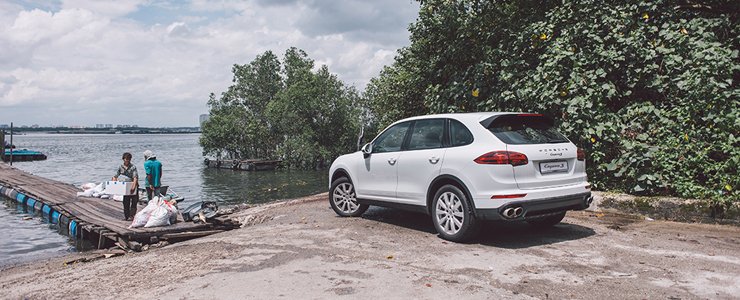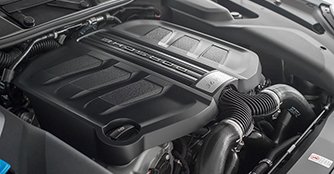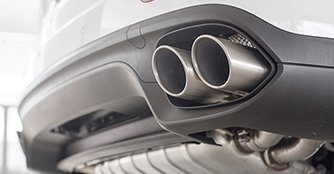Porsche Cayenne S 3.6 (A) Facelift Review
23 Mar 2015|20,912 views
Turbocharging has become a motoring byword, whereby the majority of carmakers are converging on this 'route' to meet increasingly stringent emissions standards.
Porsche is no stranger to turbocharging. The Stuttgart sports carmaker is in fact one of the first few in the industry to adopt force induction in their production models, such as the first generation of the iconic 911 Turbo back in 1975.

 Like the Macan, the 2015 Cayenne gets its design influence from the 918, such as four-point daytime running LED and its steering wheel (above)
Like the Macan, the 2015 Cayenne gets its design influence from the 918, such as four-point daytime running LED and its steering wheel (above)
Four decades on, Porsche has introduced turbocharging to almost all of its models, including the Cayenne - a polarising SUV that has raised brows (of purists) as much as it boosted profits for the sports carmaker.
And now, in a highly anticipated move, Porsche has replaced the Cayenne S' naturally aspirated V8 with a new, in-house developed twin-turbocharged V6 unit.
Up close and Personal
Less extensive than the new powertrain is what Porsche has done to the Cayenne's exterior. In fact, it's almost hard to spot what has changed in this 2015 model.
Porsche is no stranger to turbocharging. The Stuttgart sports carmaker is in fact one of the first few in the industry to adopt force induction in their production models, such as the first generation of the iconic 911 Turbo back in 1975.

Four decades on, Porsche has introduced turbocharging to almost all of its models, including the Cayenne - a polarising SUV that has raised brows (of purists) as much as it boosted profits for the sports carmaker.
And now, in a highly anticipated move, Porsche has replaced the Cayenne S' naturally aspirated V8 with a new, in-house developed twin-turbocharged V6 unit.
Up close and Personal
Less extensive than the new powertrain is what Porsche has done to the Cayenne's exterior. In fact, it's almost hard to spot what has changed in this 2015 model.
 |
The Cayenne's lightly reworked front end now looks slightly more aggressive, and bears a closer resemblance to its smaller brother, the Macan. In fact, when viewed from afar, both SUVs can be mistaken for each other.
Thankfully, there're tiny details to help distinguish this newer, bigger brother, such as the four-point rear brake lamps, which create a unique and characterful light signature - especially at night.
 |
The Drive
At the heart of this Cayenne S is a 3.6-litre twin-turbocharged unit, which produces 414bhp and 550Nm of torque. That is 20 horses more than the 4.8-litre naturally aspirated V8 block found in the previous model.

 3.6-litre twin-turbocharged V6 - also found in the Macan Turbo - has been tuned to produce 16bhp more in the Cayenne S
3.6-litre twin-turbocharged V6 - also found in the Macan Turbo - has been tuned to produce 16bhp more in the Cayenne S
The additional power grants the Cayenne S serious performance, such as a 5.5-second century sprint timing - almost half a second quicker than its predecessor.
What's more impressive, however, is how it behaves on the road. There's no doubt that the Cayenne is still a sizeable SUV, measuring 4,855mm in length, 1,939mm across and standing at 1,705mm.
But compared to other segment players, such as the Audi Q7, the BMW X5, and the Mercedes-Benz M-Class, the Cayenne is easily one of the most involving to drive.
At the heart of this Cayenne S is a 3.6-litre twin-turbocharged unit, which produces 414bhp and 550Nm of torque. That is 20 horses more than the 4.8-litre naturally aspirated V8 block found in the previous model.

The additional power grants the Cayenne S serious performance, such as a 5.5-second century sprint timing - almost half a second quicker than its predecessor.
What's more impressive, however, is how it behaves on the road. There's no doubt that the Cayenne is still a sizeable SUV, measuring 4,855mm in length, 1,939mm across and standing at 1,705mm.
But compared to other segment players, such as the Audi Q7, the BMW X5, and the Mercedes-Benz M-Class, the Cayenne is easily one of the most involving to drive.
Its agility, dynamic handling and sorted ride are similar to those of the Bimmer. But in the Cayenne, you get a more car-like seating position, which makes driving more enjoyable.

 Cayenne's boot space of 670 litres remains unchanged, which puts it in between the BMW X5's 575 litres and the Mercedes-Benz M-Class' 690 litres
Cayenne's boot space of 670 litres remains unchanged, which puts it in between the BMW X5's 575 litres and the Mercedes-Benz M-Class' 690 litres
Conclusion
For the Cayenne S, the highlight in this facelift is no doubt the new twin-turbocharged block, which packs better performance despite sporting less cylinders.
It will also help save close to $2,000 in road tax compared to the previous version - though we reckon that would be 'chump change' to its target audience.
The swop may have cost it its V8 appeal, but what continues to charm us is the SUV's sporty handling, while retaining proper practicality for the family.
In short, we have no qualms about its capability to woo local buyers - especially those after its prestigious badge.

Conclusion
For the Cayenne S, the highlight in this facelift is no doubt the new twin-turbocharged block, which packs better performance despite sporting less cylinders.
It will also help save close to $2,000 in road tax compared to the previous version - though we reckon that would be 'chump change' to its target audience.
The swop may have cost it its V8 appeal, but what continues to charm us is the SUV's sporty handling, while retaining proper practicality for the family.
In short, we have no qualms about its capability to woo local buyers - especially those after its prestigious badge.
Turbocharging has become a motoring byword, whereby the majority of carmakers are converging on this 'route' to meet increasingly stringent emissions standards.
Porsche is no stranger to turbocharging. The Stuttgart sports carmaker is in fact one of the first few in the industry to adopt force induction in their production models, such as the first generation of the iconic 911 Turbo back in 1975.
Four decades on, Porsche has introduced turbocharging to almost all of its models, including the Cayenne - a polarising SUV that has raised brows (of purists) as much as it boosted profits for the sports carmaker.
And now, in a highly anticipated move, Porsche has replaced the Cayenne S' naturally aspirated V8 with a new, in-house developed twin-turbocharged V6 unit.
Up close and Personal
Less extensive than the new powertrain is what Porsche has done to the Cayenne's exterior. In fact, it's almost hard to spot what has changed in this 2015 model.
Porsche is no stranger to turbocharging. The Stuttgart sports carmaker is in fact one of the first few in the industry to adopt force induction in their production models, such as the first generation of the iconic 911 Turbo back in 1975.
Four decades on, Porsche has introduced turbocharging to almost all of its models, including the Cayenne - a polarising SUV that has raised brows (of purists) as much as it boosted profits for the sports carmaker.
And now, in a highly anticipated move, Porsche has replaced the Cayenne S' naturally aspirated V8 with a new, in-house developed twin-turbocharged V6 unit.
Up close and Personal
Less extensive than the new powertrain is what Porsche has done to the Cayenne's exterior. In fact, it's almost hard to spot what has changed in this 2015 model.
The Cayenne's lightly reworked front end now looks slightly more aggressive, and bears a closer resemblance to its smaller brother, the Macan. In fact, when viewed from afar, both SUVs can be mistaken for each other.
Thankfully, there're tiny details to help distinguish this newer, bigger brother, such as the four-point rear brake lamps, which create a unique and characterful light signature - especially at night.
Thankfully, there're tiny details to help distinguish this newer, bigger brother, such as the four-point rear brake lamps, which create a unique and characterful light signature - especially at night.
The Drive
At the heart of this Cayenne S is a 3.6-litre twin-turbocharged unit, which produces 414bhp and 550Nm of torque. That is 20 horses more than the 4.8-litre naturally aspirated V8 block found in the previous model.
The additional power grants the Cayenne S serious performance, such as a 5.5-second century sprint timing - almost half a second quicker than its predecessor.
What's more impressive, however, is how it behaves on the road. There's no doubt that the Cayenne is still a sizeable SUV, measuring 4,855mm in length, 1,939mm across and standing at 1,705mm.
But compared to other segment players, such as the Audi Q7, the BMW X5, and the Mercedes-Benz M-Class, the Cayenne is easily one of the most involving to drive.
At the heart of this Cayenne S is a 3.6-litre twin-turbocharged unit, which produces 414bhp and 550Nm of torque. That is 20 horses more than the 4.8-litre naturally aspirated V8 block found in the previous model.
The additional power grants the Cayenne S serious performance, such as a 5.5-second century sprint timing - almost half a second quicker than its predecessor.
What's more impressive, however, is how it behaves on the road. There's no doubt that the Cayenne is still a sizeable SUV, measuring 4,855mm in length, 1,939mm across and standing at 1,705mm.
But compared to other segment players, such as the Audi Q7, the BMW X5, and the Mercedes-Benz M-Class, the Cayenne is easily one of the most involving to drive.
Its agility, dynamic handling and sorted ride are similar to those of the Bimmer. But in the Cayenne, you get a more car-like seating position, which makes driving more enjoyable.
Conclusion
For the Cayenne S, the highlight in this facelift is no doubt the new twin-turbocharged block, which packs better performance despite sporting less cylinders.
It will also help save close to $2,000 in road tax compared to the previous version - though we reckon that would be 'chump change' to its target audience.
The swop may have cost it its V8 appeal, but what continues to charm us is the SUV's sporty handling, while retaining proper practicality for the family.
In short, we have no qualms about its capability to woo local buyers - especially those after its prestigious badge.
Conclusion
For the Cayenne S, the highlight in this facelift is no doubt the new twin-turbocharged block, which packs better performance despite sporting less cylinders.
It will also help save close to $2,000 in road tax compared to the previous version - though we reckon that would be 'chump change' to its target audience.
The swop may have cost it its V8 appeal, but what continues to charm us is the SUV's sporty handling, while retaining proper practicality for the family.
In short, we have no qualms about its capability to woo local buyers - especially those after its prestigious badge.
Car Information
Porsche Cayenne S 3.6 (A)
CAT B|Petrol|10.5km/L
Horsepower
309kW (414 bhp)
Torque
550 Nm
Acceleration
5.5sec (0-100km /hr)
This model is no longer being sold by local distributor
All Used Porsche CayenneThank You For Your Subscription.










































